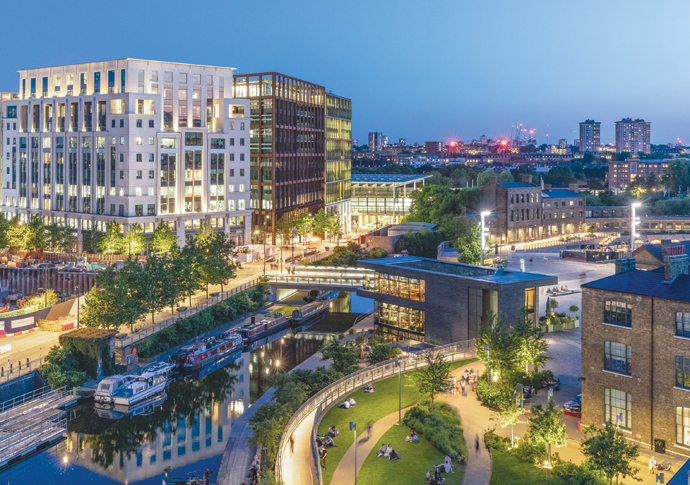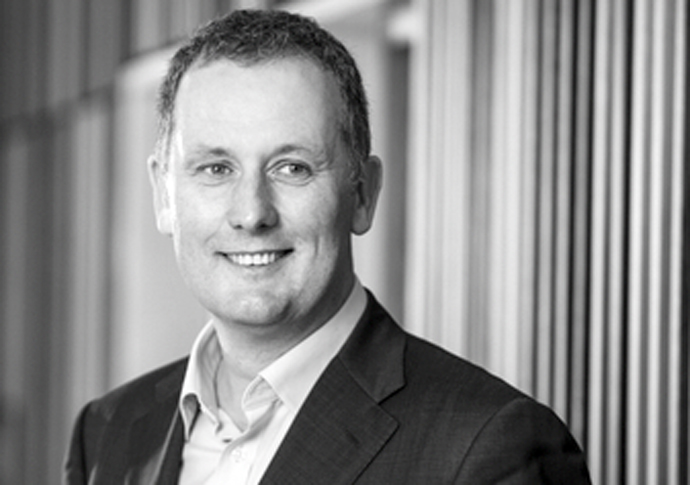‘King’s Cross was hostile and messy, but we made it lovely to walk through’
As Robert Evans, CEO of the King’s Cross estate, prepares to leave the business after 23 years, he tells Dan Carrier about his time at the helm and some of the challenges and opportunities the team faced in reducing the environmental impact of the neighbourhood
Friday, 15th December 2023 — By Dan Carrier

[Image courtesy of John Sturrock]
“FROM the outside, this sprawling brownfield site looked like a black hole in the middle of the capital,” Robert Evans recalls. “But step inside King’s Cross and it was teeming with life.”
Mr Evans joined the team behind the redevelopment in 2001. He remembers how earlier plans had not got off the drawing board – but that changed in 1996 with the decision to move the Channel Tunnel Rail Link from Waterloo to St Pancras. It became the catalyst for change. The landowners – London & Continental Railways Limited and Excel – saw this as the jump start they needed.
In 1997, the King’s Cross Central Limited Partnership (KCCLP) was formed and with the help of a government grant called the Single Regeneration Budget, things began to move for the site. Argent LLP was the development partner for the scheme and formed part of KCCLP.
“I was working for a planning consultant and Argent was a client,” he recalls. Argent’s Roger Madelin invited him on board as they drew up an initial bid.
“It felt large, very complicated and parts were in an extraordinary condition,” he says.
Mr Evans knew the area – he had danced the night away at The Cross nightclub in times gone by. “Little did I know it would later dominate my life,” he says. “It could be scary, confusing, complicated, hostile. It was a very messy place – there were obvious signs of crime, drugs and prostitution and there was a big police presence under Operation Welwyn. It was eye-opening stuff and showed the scale of the challenge.

“You looked around and thought, how is this here, right in the middle of one of the greatest cities in the world? It was in a way like a black hole in the middle of London. But of course when you entered it was full of life – independent businesses under the arches, the Coal Drops were full of things. On a Saturday night, it was really quite something.”
The exodus of the myriad of small businesses began long before Argent moved in.
The building of the Channel Tunnel rail link had meant the site was being cleared of tenants and the light industrial workshops, barrow makers and garages had for the most part moved out when Argent took the keys. “Looking back, I don’t think we knew exactly what we were taking on,” Mr Evans says.
“But you have to be a bit naive to embark on these things sometimes. We were not fully prepared for the politics and the planning issues, the challenges of previous, failed schemes. It was so complicated it blew my mind. How do you sort this out, and where do you start?”
They began with a set of guidelines to adhere to as they laid out an entirely new neighbourhood. Called Principles for a Human City, the publication was written predominantly by Mr Evans in a collaboration between multiple industry experts.
The then leader of Camden Council, Dame Jane Roberts, wrote a foreword that laid out the terms of reference for a 15-year plus project that involved landowners, Camden and Islington councils, English Heritage, the Commission for Architecture and the Built Environment, the Greater London Authority, KCCLP and a range of community groups.
The Principles had core ideas based on the economic role King’s Cross could play, enhancing equality through neighbourhood investment, creating jobs and training and providing new public services and homes. Another element was around reducing its environmental impact, ranging from urban renewal to energy efficiency, water and recycling materials.
Footnotes to the 10 principles showed an early recognition of the declining environment.
While the direction has remained the same (the estate has been built in zones, with the last being given planning permission in July for a building on the site of what used to be an all-night petrol station), Mr Evans notes the differences in emphasis 22 years ago.
“The interesting thing was sustainability. Today, there would be a much greater emphasis on a carbon and net zero.”
Earlier this week, King’s Cross confirmed it would be seeking to reach net zero carbon by 2035. It is a date reached only by understanding what is required.
“Back then there was no net zero,” Mr Evans says. “We looked at how we produced and used energy efficiently.”
Early ideas included using “lollipop” wind turbines – they did not find a permanent home and the installation of solar panels.
“There were broad principles that covered water use, minimising waste,” he says.
“In the construction process we used the BREEAM metrics and sought to make sure each building was rated ‘excellent’. We drew up an energy strategy that focused on the estate’s infrastructure.”

Robert Evans
A centralised heat and power system which today uses green gas helped future proof the site and was truly innovative for its time.
“There is one energy centre that supplies the estate,” he says.
“Most other buildings at the time had their own gas boilers and plant rooms. What we did was cutting edge. 20 years ago, combined heat and power units were almost unheard of. Now we have replaced a fossil fuel with a green gas – but we are still burning a gas. The time has come to switch to ground and air source heat pumps. It is part of our net zero strategy. We have come a long way. It shows how things have changed,” he says.
“And the good thing is we do not have to change each building.”
The final piece of the planning jigsaw is a building soon to rise over the Regent’s Canal.
What has been designed today will cost a significantly higher figure than the same project would have 20 years ago.
“We have, of course, faced cost inflation for materials,” Mr Evans says. “But it is also because we are constructing a net zero carbon building and that wasn’t on the agenda back then. We use completely different standards.”
As materials have improved, how to audit their impact has also scaled up.
“The challenge is embodied carbon in concrete,” he says. “It means looking for innovative answers, found in new composite materials.
“It costs money but we are convinced it is the right thing to do – and it is what occupiers want.
“There will be a premium for the best buildings, better windows, roof terraces, balconies.
“It is commercially important too. It will be the difference between someone wanting to rent a space or not. People want progressive buildings. People care about these decisions.”
A welcome aspect of the King’s Cross estate is the absence of cars, combined with an “on your doorstep” atmosphere for people living or working there.
This was an idea cooked up two decades before “15-minute” cities were in the public eye.
“We never called it a 15-minute city, but the idea was to have a neighbourhood with everything within walking distance,” Mr Evans adds. We wanted to create a piece of city, with excellent transport links, lovely streets to walk and cycle through. The concept was a personable, walkable neighbourhood.”
Mr Evans has a way of gauging the success of a 22-year project, and it’s not from rents or occupiers.
He said: “For me, the test is how King’s Cross is doing at the weekends. When you see thousands of people walking up and down the Boulevard – that has to be a mark of its success and something I will treasure always as I leave Argent and King’s Cross to pursue other opportunities.”